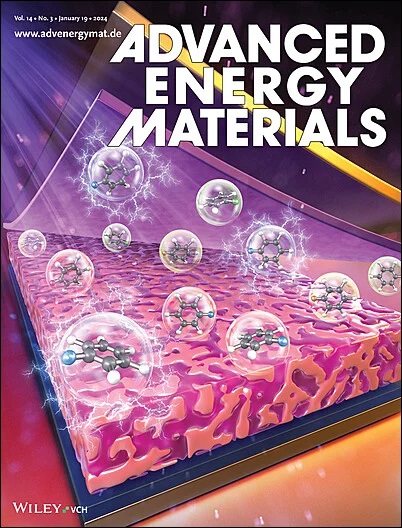Manipulating Zn2+ Depletion Zones and Deposition Kinetics via Self‐Concentrating Micro‐Reservoirs for Ah‐Scale Zn Metal Batteries
IF 24.4
1区 材料科学
Q1 CHEMISTRY, PHYSICAL
引用次数: 0
Abstract
The glass fiber separator is a critical component in Zn metal batteries (ZMBs), but its disordered pores inadequately regulate the flow of anions and cations, leading to uncontrolled dendrite growth. Herein, the integration of ion self‐concentrating zincized hectorite (Zn‐HEC) layers into the separator is introduced and their crucial role in managing ion distribution and solvation on the surface of the Zn anode during battery operation is revealed. Density functional theory demonstrates that Zn‐HEC possesses a notable Zn通过自浓缩微储层控制锌金属电池的Zn2+枯竭带和沉积动力学
玻璃纤维隔膜是锌金属电池(zmb)的关键部件,但其无序的孔隙不能充分调节阴离子和阳离子的流动,导致枝晶生长不受控制。本文介绍了离子自浓缩锌化hectorite (Zn - HEC)层在电池运行过程中对锌阳极表面离子分布和溶剂化的控制作用。密度泛函理论表明,Zn‐HEC具有显著的Zn2+自富集能力,可作为微区Zn2+储层,促进Zn2+的快速均匀输送。这一特性防止了锌沉积过程中Zn2+贫带的形成。此外,掺入的Zn‐HEC有效地抑制了SO42−的迁移,并显著降低了水合Zn2+的脱溶屏障。因此,Zn‐HEC促进Zn沿Zn阳极的(002)晶体平面均匀沉积,在20ma cm - 2下,5mah cm - 2的寿命超过2000小时,在50 mA cm - 2 (10 mAh cm - 2)的超高速率下,循环寿命达到500小时。此外,具有1.6 Ah容量的I2||GF@Zn‐HEC||锌袋电池在200次循环中表现出出色的循环稳定性。本研究介绍了一种优化下一代zmb中锌沉积的新方法。
本文章由计算机程序翻译,如有差异,请以英文原文为准。
求助全文
约1分钟内获得全文
求助全文
来源期刊

Advanced Energy Materials
CHEMISTRY, PHYSICAL-ENERGY & FUELS
CiteScore
41.90
自引率
4.00%
发文量
889
审稿时长
1.4 months
期刊介绍:
Established in 2011, Advanced Energy Materials is an international, interdisciplinary, English-language journal that focuses on materials used in energy harvesting, conversion, and storage. It is regarded as a top-quality journal alongside Advanced Materials, Advanced Functional Materials, and Small.
With a 2022 Impact Factor of 27.8, Advanced Energy Materials is considered a prime source for the best energy-related research. The journal covers a wide range of topics in energy-related research, including organic and inorganic photovoltaics, batteries and supercapacitors, fuel cells, hydrogen generation and storage, thermoelectrics, water splitting and photocatalysis, solar fuels and thermosolar power, magnetocalorics, and piezoelectronics.
The readership of Advanced Energy Materials includes materials scientists, chemists, physicists, and engineers in both academia and industry. The journal is indexed in various databases and collections, such as Advanced Technologies & Aerospace Database, FIZ Karlsruhe, INSPEC (IET), Science Citation Index Expanded, Technology Collection, and Web of Science, among others.
 求助内容:
求助内容: 应助结果提醒方式:
应助结果提醒方式:


